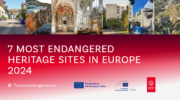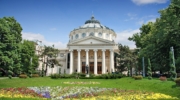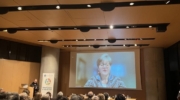European experts issue report for the rehabilitation of Ererouyk and Anipemza, Armenia
Europa Nostra, the leading heritage organisation in Europe, and the European Investment Bank Institute made public on 10 April 2017 a technical and financial report for the safeguarding and enhancement of the archaeological site of Ererouyk and the village of Anipemza in Armenia, listed among the 7 Most Endangered heritage sites in Europe in 2016. It is proposed to enhance the cultural heritage assets in a way to allow the improvement of the living conditions of the local population, thus setting an example of a viable and sustainable approach to the promotion of cultural tourism development in Armenia.
Sitting on a rocky plateau close to the Turkish‐Armenian border, Ererouyk was once one of the most important centres of worship in the region. Despite some restoration works undertaken in the last two decades, the basilica, which is on the UNESCO World Heritage tentative list, remains highly endangered. The surrounding archaeological area is at risk of being lost before it can be comprehensively studied. The village of Anipemza is situated a few hundred metres from Ererouyk. Probably designed by the Armenian architect Alexander Tamanyan, it was built in 1926 to accommodate the workers of the nearby industrial complex. Since 1994, with the closing of the mine, the village has been gradually abandoned and the condition of the houses has deteriorated. The Republic of Armenia, through the Ministry of Culture, is the owner of the site that was nominated for the 7 Most Endangered programme 2016 by the Centre of Studies and Documentation of Armenian Culture in Italy (CSDCA).
“The main goal is to implement an exemplary project that combines the enhancement of the cultural heritage of Ererouyk and Anipemza with the improvement of the living conditions of the inhabitants of the village,” states the report prepared by Mario Aymerich and Guy Clausse, Technical Consultants appointed by the European Investment Bank Institute, in collaboration with various national and European experts.
The project has several components: the development of scientific studies, management plan and project design; conservation works at Ererouyk’s basilica and surrounding archaeological area and the enhancement of the Anipemza village; the creation of two museums; the promotion of small commercial activities and training for the local population; and the implementation of promotional and communication activities, including an international event and a website dedicated to the project.
The following key recommendations are put forward in the report:
1) a Project Implementation Unit should be created to manage the entire process;
2) throughout the project, there should be close collaboration with the local authorities to guarantee full respect of national and international norms; open participation of stakeholders (including full involvement of the inhabitants); and participation of local experts to favor the exchange of ideas and inputs;
3) an International Scientific Committee should be set up to provide the necessary technical advice, defining the rules that will protect the village and its surrounding area from an over-use and supervising the preservation works;
4) an Environmental Feasibility Assessment should be carried out; and
5) due attention should be paid to the operational issues and maintenance of the whole system, in particular if this is implemented gradually.
According to the report, taking into account the vicinity of the airport in Gyumri and the global tourism demand in Armenia, the project could attract some 40,000-50,000 visitors (about 5% of the annual tourist inflow in Armenia).
“It would be important to consider the development of Ererouyk and Anipemza as a first step towards the development of a future North tourist corridor in Armenia and to take action to link the site to the projects envisaged for the development of Gyumri,” emphasised the European experts.
The project has an estimated cost of 5 million euros (excluding taxes and other financial charges) and could be carried out in four years.
The technical and financial report was formulated on the basis of the outcomes of a five-day mission in Armenia in July 2016, during which delegates from Europa Nostra, the European Investment Bank Institute and the Centre of Studies and Documentation of Armenian Culture in Italy (CSDCA) visited Ererouyk and Anipemza and met with local and national stakeholders. The report is also the result of interchanges of information and discussions between experts from different organisations.







